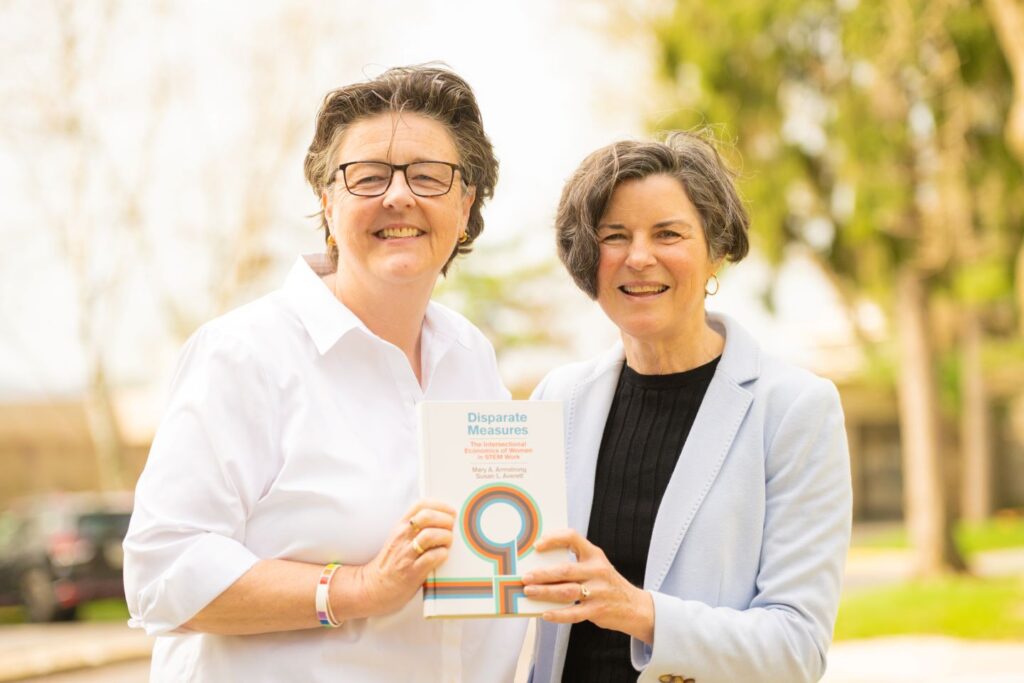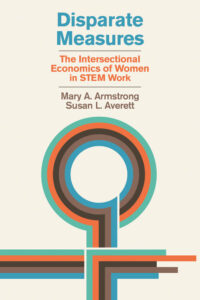Learn more
- Prof. Mary Armstrong returned to her alma mater, Duke University, on March 24 to moderate a discussion with Kimberlé Crenshaw, noted law professor, civil rights leader, and executive director of the African American Policy Forum.
Despite promises of STEM field success, diverse women face challenging workplace climates and inequities in pay
By Bryan Hay
In their first co-authored book, Profs. Mary Armstrong and Susan Averett reveal that diverse women in STEM fields, despite the promise and expectation of economic abundance, do not fare as well economically as white men in the same professions.
Published by MIT Press and released April 9, Disparate Measures: The Intersectional Economics of Women in STEM Work represents almost eight years of research and interdisciplinary collaboration by Armstrong, Charles A. Dana Professor of Women’s, Gender & Sexuality Studies and English and Averett, Charles A. Dana Professor of Economics.
Tapping into data from the American Community Survey, published by the Census Bureau, which provides vital information on the U.S. and its people, their book focuses on the STEM participation and earnings of intersectional groups of women in STEM. They present four in-depth case studies examining Black women; American Indian and Alaska Native women; Asian and Pacific Islander women; and Hispanic women. Also included are four case studies of women who are frequently bypassed by the STEM inclusivity literature: foreign-born women, women with disabilities, queer women, and mothers.

Profs. Mary Armstrong (left) and Susan Averett
Years in the making, their book documents the inequities and offers hopeful recommendations for rethinking STEM equity.
The project began when an editor at MIT Press approached Averett, whose research interests include gender and the economy, about her interest in developing a book project.
“I talked to Mary, who has an interest in gender studies and was doing a lot of work in STEM already ,” Averett recalls. “She’s very much an expert on that. We decided that maybe we could make something out of this.”
Armstrong and Averett found interdisciplinary synergy almost immediately, and their inherently collaborative work is aimed at scholars, Ph.D. students, policymakers, and others interested in better understanding the situation for diverse women working in STEM and how to level the playing field in STEM professions.
“We’d gotten to know each other professionally through Susan’s generous service on the Women’s, Gender and Sexuality Studies Advisory Committee, and we thought this would be a perfect opportunity to work together,” Armstrong says.
“MIT was supportive all the way through,” Averett adds. “We had a marvelous editor who believed in the project and believed in us. And we worked on the project weekly.”
Asked if their results surprised them, Averett notes that she and Armstrong were well aware of gender wage gaps as they started their research but agreed that the economic story of diverse women in STEM had not been sufficiently explored. While it’s common to say that STEM fields are great for women, that only holds true if you compare women in STEM jobs to those in non-STEM jobs.
“But once you start to compare diverse women to white men, which is the category that has the highest elevation and status in the labor market, well, then they don’t fare well at all,” Averett says.
“We wanted to deliver it in a framework that really challenged people to think about the way that we laud STEM careers as a source of equity and social mobility for diverse women,” Armstrong adds. “We wanted to take data and make it shine backwards onto the social situation to say hey, we promise diverse women, if you go into STEM, you will be elevated in terms of earnings and this is the road to economic justice and glory. And that is not the reality.”

Disparate Measures: The Intersectional Economics of Women in STEM Work (MIT Press) by Profs. Mary Armstrong and Susan Averett
Opportunities abound to reverse course on wage disparities for women in STEM professions, starting at Lafayette.
“We should examine the economics of STEM as we try to promote participation through entities like the Hanson Center for Inclusive STEM,” Armstrong says. “When we think about how to get certain groups into STEM, we often stop there. And we don’t think about what happens once they actually enter STEM careers. We’re so worried about getting them through the doorway, we don’t always think about what happens once they’re in the room.”
“It’s a matter of getting them in the door,” says Averett, picking up on Armstrong’s point. “But it’s also a matter of what they choose to do. For example, the natural sciences tend to attract more women, but they’re not the higher-paying STEM jobs. So that’s another issue that goes along with unpacking this narrative around the promise of STEM.”
Hope
“If you’re going want to solve a problem, hope lies in understanding the problem better,” Armstrong offers. “And while it may be somewhat discouraging to see the depth and extent of the problem, the better you see it, the more hope for addressing it.
“Our final chapter offers different ways to think about STEM equity, to rely less, for example, on the idea of proportional representation, and to think more carefully about promises made around STEM as a source of economic success for everyone or equity for everyone,” she adds.
While the numbers seem grim, the book suggests there are opportunities to address them, Averett says
“Mary is right; you’ve got to name the problem, and shine a light on it,” Averett offers. “We have to tell people something that they may think they know but they don’t really have the full picture. That’s a positive thing.”
“Until you name the problem precisely and with some sophistication, you will never solve it,” Armstrong says. “Ultimately, our book is helpful in that regard. The second thing is that there are a lot of diverse women in STEM right now. And they deserve a book that says, we see you.”